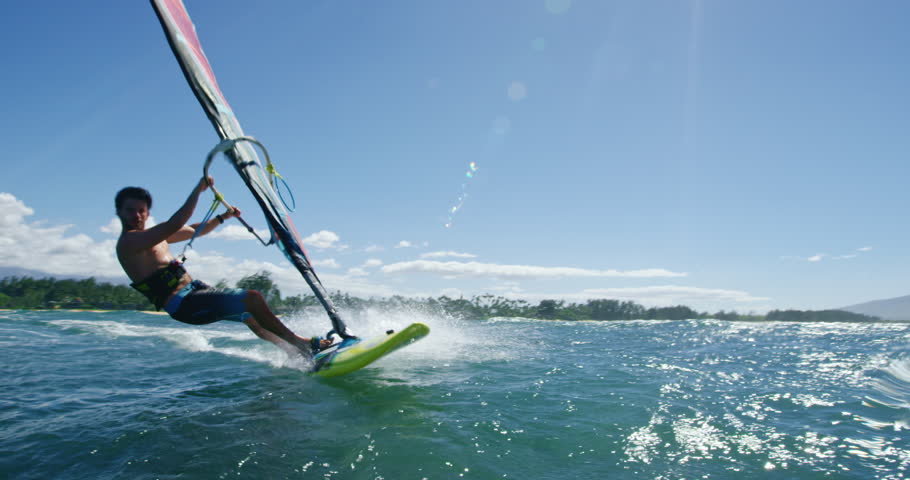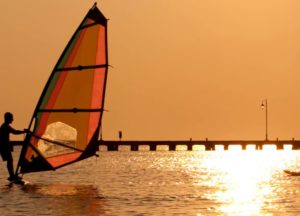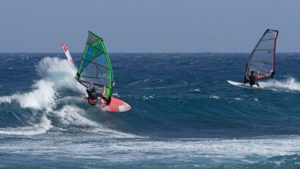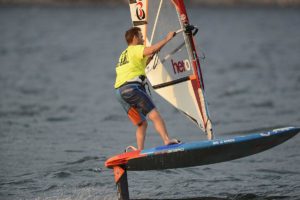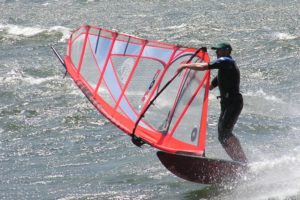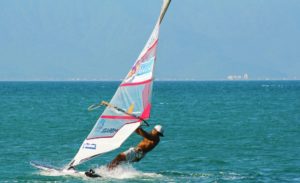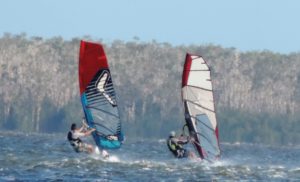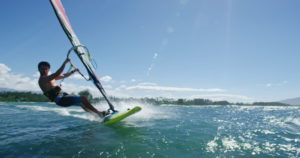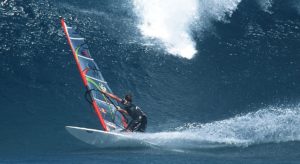Windsurfing emerged as a popular water sport around 1970. The development was based on ways to harness the wind to propel a craft through the water.
A windsurfer, or sailboard, is basically a board like a surfboard that uses a sail to propel it through the water. The action of moving the sail with respect to the direction of the wind helps to turn the windsurfer. Turning is also assisted by digging the board into the water.
It has long been believed that Polynesians had been using the concept of standing on a board with an upright sail for trips over the ocean. However, the accreditation of the design of the modern windsurfer and associated patents has only been a recent event.
Who Invented the Windsurfer/Sailboard
It is generally considered that in 1948 a young man called Newman Darby cam up with the idea of using a handheld sail on a small catamaran. Newman’s concept was to mount the sail on the catamaran via a universal joint that allowed the sail to be placed in a wide range of movement. However, Newman didn’t register his idea so wasn’t able to claim a patent.
In the 1960s Fred Drake joined up with Hoyle Schweitzer to further refine Darby’s concept and eventually led to a patent on the windsurfer.
The Windsurfing Invention
The main problem that had to be overcome with a windsurfer was the fact that there would be no rudder, as this would be simply too complex for a sailor to manage. A sailor has to control the power from the sail and the direction of the board.
In the early sailing ships, that cruised the world in the 1600s, the main way of steering was to use the sails on the top of the twin masted vessels. Each sail on each mast would apply a different force on the ship, and so the ship could be steered. With this type of steering, the rudder was only used for fine-tuning.
This concept of two masts was impractical on a sailboard with one person, so Drake focussed on moving the sail in all directions so the angle of attack of the sail to both the wind and the board could be changed at will. This allowed control over power and direction.
To achieve this successfully required a universal joint that allowed the sail to be rotated, as well as moved forward and back.
The final addition was the wish-bone boom that allowed the sailor to hold the sail from both sides of the sail.
The Windsurfer Patent
Drake and Schweitzer eventually applied for the patent for their design and this was granted in 1970.
The patent abstract for the windsurfer (US Patent 3,487,800) is:
“Wind-propelled apparatus in which a mast is universally mounted on a craft and supports a boom and sail. Specifically a pair of curved booms are accurately connected athwart the mast and secure the sail there between, the position of the mast and sail being controllable by the user but being substantially free from pivotal restraint in the absence of such control.”
Windsurfing Popularity
Drake and Schweitzer made their first windsurfers from wood, but these were heavy and difficult to produce. Boards made from polyethylene were developed. These were able to be mass-produced quickly and cheaply and the craze of windsurfing quickly took off.
Further refinements followed as the sport of windsurfing developed.
- Harnesses, worn on the back or chest, allowed the sailboarder to hook in to a rope on the boom. This takes a large amount of the strength off the arms providing the sailor the ability to spend many long hours on the water without fatiguing.
- Footstraps on the board allowed the sailor to remain securely connected to the board at high speed. With a sailor hooked in a harness, and feet in the footstraps, the sailor’s body effectively becomes part of the whole rig.
- Unique sailing techniques developed such as the windsurfing duck gybe.
- Fibreglass boards meant a sailor can make up a custom sailboard to suit their individual needs.
- Sailboards became smaller requiring a deep water start in high winds to get moving. And allowed for exciting windsurfing techniques like the windsurfing chop jump.
- Windsurfing moved into the surf providing spectacular scenes as sailors performed high jumps and loops off the waves.
In 1973, the first world championship of windsurfing was held and in 1984 windsurfing became an Olympic sport.
Windsurfing has slowly lost its popularity from the halcyon days of the 1980s. However, many practitioners of the sport can be found on the windy waterways of the world.

